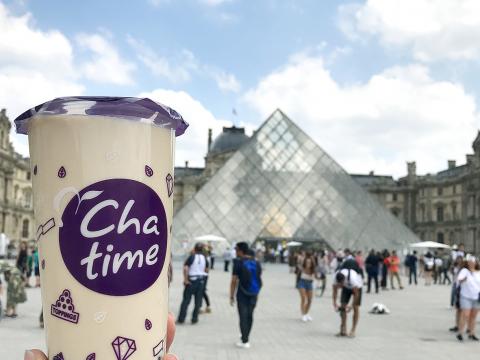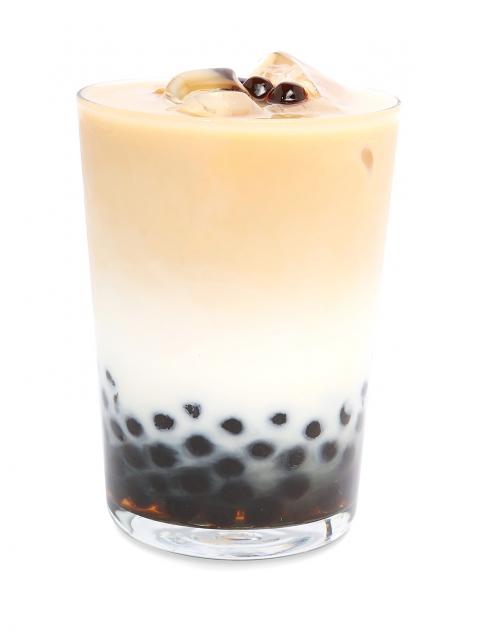Bubble tea, also called pearl tea (珍珠奶茶), is a quintessentially Taiwanese drink, but how old is the chewy tapioca ball-filled beverage, who invented it and how did it become to be so popular?
The origins of bubble tea are steeped in mystery and still hotly debated, but according to the orthodox version of events, the story begins in 1980s Taiwan.
At the time something called “bubble tea” — quite different from the drink we know today — was all the rage. Made with either black tea or green tea, brewed tea was sweetened with sugar syrup and then shaken through ice in a cocktail shaker to both chill the tea and produce a copious amount of bubbly froth at the top of the glass, similar to a “head” on a freshly poured pint of beer. The shaking was initially done by hand, but later machines were developed to automatically agitate the tea mixture.

Photo: Yang Ya-min, Taipei Times
At some point, chewy tapioca balls (粉圓) were added to bubble tea, resulting in pearl milk tea, the familiar drink we know today. Two rival Taiwanese teahouse chains — Hanlin Tea Room (翰林茶館) in Tainan and Chun Shui Tang (春水堂人文茶館) in Taichung — lay claim to conceiving the bubbly beverage.
DISPUTE OVER ORIGINS
Hanlin Tea Room insists it came up with the idea in 1986 when its founder Tu Tsung-ho (?宗和) spotted white-colored tapioca balls on sale at Tainan’s Yamuliao market. Tu had a sudden flash of inspiration and bought some of the balls home, and after cooking them through, added them to some milk tea. He found the texture pleasing and soon christened the new beverage pearl milk tea on account of the pearly, semi-translucent white tapioca balls. To this day, customers at any branch of Hanlin Tea Room can choose between either the original white tapioca balls or the more common black variety, made with brown sugar.

Photo Courtesy of Cha Cha The
However, Chun Shui Tang maintains it is the true inventor of the beverage, which it says was created by a then-20-year-old female employee, Lin Hsiu-hui (林秀慧), the following year in 1987. One day at the teahouse, Lin experimented by mixing her favorite childhood snack, tapioca balls, with iced milk tea and also lemon black tea to produce what the company claims was the world’s first cup of pearl milk tea.
The two companies became locked in a bitter dispute, filing lawsuits against each other and eventually going to court to settle the matter. However, since neither one was able to successfully patent or trademark their product, by the mid-1990s, pearl milk tea featured on the menus of Taiwan’s teahouses, which were popular hangouts for students and businessmen to relax and chew the cud in the days before the influx of coffee shops. With the introduction from abroad of machines that automatically seal the top of takeaway cups with a thin film of plastic, the modern takeaway version of the beverage was born.
ANOTHER THEORY
However, there is an intriguing alternative explanation: bubble tea’s earliest incarnation could in fact be traced back to the days of the British empire. In British Malaya (modern-day Singapore and Malaysia) an iced drink/desert, usually called cendol or chendol, began to be drunk to provide respite from the tropical heat.
Brightly-colored, worm-like gelatinous strands, usually made from rice flour or sago, are added to coconut milk which has been sweetened with sugar and combined with ice to make a refreshing drink or iced snack. It is thought that cendol may have been inspired by locals observing British expatriates adding milk to their tea and may have originated in port cities such as Malacca or Penang, where refrigeration technology from British ships would have provided the ice. Today, Cendol is a ubiquitous thirst-quencher drunk across South East Asia, including Thailand, Vietnam and Indonesia and when served in a tall glass, bears an uncanny resemblance to Taiwan’s bubble tea.
Meanwhile, chewy tapioca balls, called fenyuan in Chinese, somehow made their way to Taiwan from abroad — possibly via China, after being presented to Empress Dowager Cixi (慈禧太后) as tribute — and began to be used as an ingredient in sweet snacks at Taiwanese night markets. Contrary to the competing claims of the teahouses, perhaps the real origin of bubble tea is to be found in Taiwan’s night markets, possibly inspired by a Taiwanese night market vendor sipping on a glass of cendol during a trip to Singapore or Malaysia.
Whatever the true origin of bubble tea, today takeaway tea shops abound on almost every street corner and rival chains fiercely compete for business, continually innovating wacky new flavor combinations and textures to keep customers coming back for more. In recent years, Taiwan’s quasi-national beverage has successfully seen off the coffee juggernaut as well as multiple food safety scares and looks set to stay a permanent fixture of Taiwan’s culinary scene for many years to come.

A “meta” detective series in which a struggling Asian waiter becomes the unlikely hero of a police procedural-style criminal conspiracy, Interior Chinatown satirizes Hollywood’s stereotypical treatment of minorities — while also nodding to the progress the industry has belatedly made. The new show, out on Disney-owned Hulu next Tuesday, is based on the critically adored novel by US author Charles Yu (游朝凱), who is of Taiwanese descent. Yu’s 2020 bestseller delivered a humorous takedown of racism in US society through the adventures of Willis Wu, a Hollywood extra reduced to playing roles like “Background Oriental Male” but who dreams of one day

Gabriel Gatehouse only got back from Florida a few minutes ago. His wheeled suitcase is still in the hallway of his London home. He was out there covering the US election for Channel 4 News and has had very little sleep, he says, but you’d never guess it from his twinkle-eyed sprightliness. His original plan was to try to get into Donald Trump’s election party at Mar-a-Lago, he tells me as he makes us each an espresso, but his contact told him to forget it; it was full, “and you don’t blag your way in when the guy’s survived two

The entire saga involving the Taiwan People’s Party (TPP) and its Chairman Ko Wen-je (柯文哲) continues to produce plot twists at such a rapid pace that fiction publishers would throw it out for being ridiculously improbable. This past week was particularly bizarre, but surprisingly the press has almost entirely ignored a big story that could have serious national security implications and instead focused on a series of salacious bombshell allegations. Ko is currently being held incommunicado by prosecutors while several criminal investigations are ongoing on allegations of bribery and stealing campaign funds. This last week for reasons unknown Ko completely shaved

The self-destructive protest vote in January that put the pro-People’s Republic of China (PRC) side in control of the legislature continues to be a gift that just keeps on giving to the Chinese Nationalist Party (KMT). Last week legislation was introduced by KMT Legislator Weng Hsiao-lin (翁曉玲) that would amend Article 9-3 of the Act Governing Relations Between the People of the Taiwan Area and the Mainland Area (臺灣地區與大陸地區人民關係條例) to permit retired and serving (!) military personnel to participate in “united front” (統戰) activities. Since the purpose of those activities is to promote annexation of Taiwan to the PRC, legislators